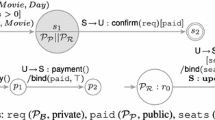Abstract
The starting point for an easy-to-read and nearly unambiguous description of a protocol is an informal description which is broken down according to the individual tasks the protocol has to fulfill. The description of the individual tasks is further subdivided into informal descriptions of actions through which these tasks can be fulfilled as a function of past history. A general part describes the manner in which the individual tasks are interrelated. The easy-to-read informal description is refined step by step until a formal description with the highest possible degree of unambiguousness is arrived at.
The result is a description that contains all refinement steps from the informal to the formal description. This paper presents a scheme for the decomposition and the contents of such a description. This scheme is suited for describing services, protocols and the interaction between service and protocol.
Access this chapter
Tax calculation will be finalised at checkout
Purchases are for personal use only
Preview
Unable to display preview. Download preview PDF.
Similar content being viewed by others
References
Bochmann, Gregor V. and Sunshine, Carl A. “Formal Methods in Communication Protocol Design” IEEE Transactions on Communications, Vol. Com-28, No. 4, April 1980, pp. 624–631
Day, John D. and Sunshine, Carl A. (editors) “A Bibliography on the Formal Specification and Verification of Computer Network Protocols” IFIP Working Group 6.1 (INWG) Study Group C, published in: Computer Communication Review, vol. 9, 1979, no 4, pp. 23–39
Goguen, Tardo, Tardo “An Introduction to OBJ: A Language for Writing and Testing Formal Algebraic Program Specifications” Proceedings of the Conf. on Reliable Software, pp. 170–189, Boston, 1979
ISO/TC 97/SC 16/WG1 “Proposed Guidelines for Informal Specifications of Protocols for OSI” Meeting on Formal Description Techniques, 1980
Mattern, K.; Weitz, H.; Zorn, S. “VMP PASCAL, an Extended Language for the Implementation of Data Communication Protocols” GI-Conference on Communication in Distributed Data Processing Systems, TU Berlin, 1981
Parnas, D.L. “On the Criteria to be used in Decomposing Systems into Modules” CACM 15, 12/1972), pp. 1053–1058
Roubine, Oliver and Robinson, Lawrence, Lawrence “Special Reference Manual 3rd Edition” Stanford Research Institute, Technical Report CSG-45, Jan. 1977
Schindler S., Marxen H., Müller-Zimmermann B. “The OSA Project: Automatic Generation of Efficient Code for RSPL Specifications” TU Berlin, FB 20, TR79–16
Schindler, S. “Algebraic and Model Specification Techniques” Proceedings of the 13th Hawaii International Conference on System Sciences, Jan. 3–4, 1980, Honolulu
Schindler, S. “The OSA Project: RSPL - A Reliable Software Production Language” Proceedings of the International Microcomputers Minicomputers Microprocessors/DATACOM 80 Conference,’ Geneva, June 1980
Schwichtenberg, G. “Formale Beschreibungsmittel für offene Kommunikationssysteme im Rahmen von Normungsvorhaben” GI-Fachtagung Formale Modelle für Informationssysteme, Tutzing, May 1979, pp. 202–219
Author information
Authors and Affiliations
Editor information
Editors and Affiliations
Rights and permissions
Copyright information
© 1981 Springer-Verlag Berlin Heidelberg
About this chapter
Cite this chapter
Stemberger, K. (1981). Towards an Easy-to-read and Unambiguous Description of Data Communication Protocols. In: Schindler, S., Schröder, J.C.W. (eds) Kommunikation in verteilten Systemen. Informatik-Fachberichte, vol 40. Springer, Berlin, Heidelberg. https://doi.org/10.1007/978-3-642-67978-0_25
Download citation
DOI: https://doi.org/10.1007/978-3-642-67978-0_25
Publisher Name: Springer, Berlin, Heidelberg
Print ISBN: 978-3-540-10618-0
Online ISBN: 978-3-642-67978-0
eBook Packages: Springer Book Archive




